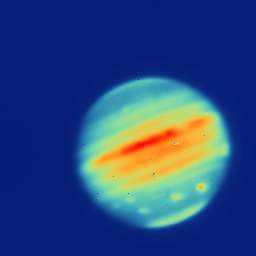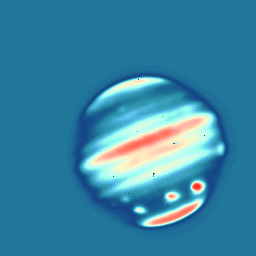
 .
.
In conjunction with the University of Wyoming, the University of Rochester presents a sampling of images displaying the effects of the collision between fragments of the Schoemaker-Levy 9 comet and the gas giant Jupiter.
The telescope to which the University of Rochester's infrared camera was attached is the Wyoming Infrared Observatory, a 92-inch telescope atop the 9,656-foot Jelm mountain near Laramie, Wyoming.
The camera has a 256x256 InSb detector array, and the observations were obtained through a 2 to 2.5 percent CVF (Continuously Variable Filter).
Observations made by Judy Pipher, Eric Howard, Craig McMurtry, Bill Forrest (U of Rochester), Chick Woodward, Bob Howell, Tracy Hodge (U of Wyoming), and Bob Gehrz (U of Minnesota).
The left image is an image of Jupiter just outside the peak of a methane absorption band. The right image is at 1.7 microns in the peak of the methane absorption band. Notice the contrast of the C, A, and E (left to right) impact sites enhanced in the methane band wrt the reduced intensity of the equatorial region.
These two images were taken out and in another methane absorption band, 2.08 and 2.18 microns respectively.
The left image is at the wavelength of the auroral zones' H[3]+ emission, 3.5 microns. The identification of the E spot emission has not been made. The right image is at 4 microns and the impact sites are not clearly visible.